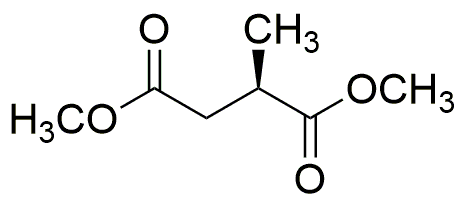Dimethyl (R)-(+)-methylsuccinate is widely utilized in research focused on:
- Flavor and Fragrance Industry: This compound is used as a flavoring agent in food products and beverages, providing a fruity aroma that enhances the sensory experience.
- Pharmaceutical Applications: It serves as an intermediate in the synthesis of various pharmaceuticals, contributing to the development of effective drug formulations.
- Polymer Production: The compound is employed in the production of specialty polymers, improving material properties such as flexibility and durability.
- Biochemical Research: Researchers utilize it in studies related to metabolic pathways, helping to understand the role of esters in biological systems.
- Cosmetic Formulations: It is incorporated into cosmetic products for its emollient properties, enhancing skin feel and moisture retention.
General Information
Properties
Safety and Regulations
Applications
Dimethyl (R)-(+)-methylsuccinate is widely utilized in research focused on:
- Flavor and Fragrance Industry: This compound is used as a flavoring agent in food products and beverages, providing a fruity aroma that enhances the sensory experience.
- Pharmaceutical Applications: It serves as an intermediate in the synthesis of various pharmaceuticals, contributing to the development of effective drug formulations.
- Polymer Production: The compound is employed in the production of specialty polymers, improving material properties such as flexibility and durability.
- Biochemical Research: Researchers utilize it in studies related to metabolic pathways, helping to understand the role of esters in biological systems.
- Cosmetic Formulations: It is incorporated into cosmetic products for its emollient properties, enhancing skin feel and moisture retention.
Documents
Safety Data Sheets (SDS)
The SDS provides comprehensive safety information on handling, storage, and disposal of the product.
Product Specification (PS)
The PS provides a comprehensive breakdown of the product’s properties, including chemical composition, physical state, purity, and storage requirements. It also details acceptable quality ranges and the product's intended applications.
Certificates of Analysis (COA)
Search for Certificates of Analysis (COA) by entering the products Lot Number. Lot and Batch Numbers can be found on a product’s label following the words ‘Lot’ or ‘Batch’.
*Catalog Number
*Lot Number
Certificates Of Origin (COO)
This COO confirms the country where the product was manufactured, and also details the materials and components used in it and whether it is derived from natural, synthetic, or other specific sources. This certificate may be required for customs, trade, and regulatory compliance.
*Catalog Number
*Lot Number
Safety Data Sheets (SDS)
The SDS provides comprehensive safety information on handling, storage, and disposal of the product.
DownloadProduct Specification (PS)
The PS provides a comprehensive breakdown of the product’s properties, including chemical composition, physical state, purity, and storage requirements. It also details acceptable quality ranges and the product's intended applications.
DownloadCertificates of Analysis (COA)
Search for Certificates of Analysis (COA) by entering the products Lot Number. Lot and Batch Numbers can be found on a product’s label following the words ‘Lot’ or ‘Batch’.
*Catalog Number
*Lot Number
Certificates Of Origin (COO)
This COO confirms the country where the product was manufactured, and also details the materials and components used in it and whether it is derived from natural, synthetic, or other specific sources. This certificate may be required for customs, trade, and regulatory compliance.

